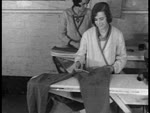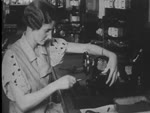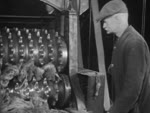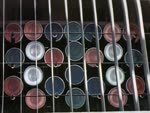GEORGE BENNIE RAILPLANE SYSTEM OF TRANSPORT
Full length video
Please read Understanding catalogue records for help interpreting this information and Using footage for more information about accessing this film.
Title: GEORGE BENNIE RAILPLANE SYSTEM OF TRANSPORT
Reference number: 1341
Date: 1929 - 1930
Sound: silent
Original format: 35mm
Colour: bw
Fiction: non-fiction
Running time: 20.00 mins
Description:
Technical record of the construction of the railplane, invented by George Bennie. Opening of trial stretch of track and the railplane in operation.
Original carriage designed with 2-bladed propeller and later modified to 4-bladed model (see ref. 0422 BENNIE RAILPLANE).
Documentation and photographs held by Glasgow University Archives.
Preservation of this film supported by the National Heritage Memorial Fund.
Shotlist:
REEL I
Credits (.11); Erected over the LNER lines at Milngavie near Glasgow. You will note the interesting co-incidence of the Railplane Line - 1929 - being opened one hundred years after the George Stephenson line - 1829 (.26); Shot of commemorative brochure of the opening of the Railplane (.35); The introduction of the George Bennie System marks as great a step in the evolution of rail transport as the motor car did over the stage coach in road transport. It is also the outcome of an insistent demand for safe and rapid transport. It would not be inappropriate if we started with the "Father" of railway locomotion George Stephenson's "Rocket" (1.12); Model replica of "Rocket" on tracks (1.21); Now watch the great modern locomotive. Shot of steam locomotive rattling past the camera, (1.27); Today the call is for greater and greater speed - with safety. George Bennie has gone to the air for it but with a rigid craft on a definite line. (1.40); Let us proceed with the construction. Our first visit is to the Teesside Bridge and Iron Company, where the elevated track is manufactured. Brief shot across works. Here is the foundry where the moulds are made. Shot of men at work over the moulds (2.12); And the great rolling mills. Shots inside a rolling mill of machinery and men at work (2.48); Outside, the various parts of the track are being assembled. The main suspension girder which supports the carrying rail. General views of same and fixing of trestles in position. (3.31); Here is the main suspension girder being assembled and rivetted. General views of riveters at work. Shot from above of shop floor (4.11); Now we must go to Milngavie where the elevated track is being erected over a section of the LNER. General views of workmen and during assembly (5.10); While the work proceeds here, the factory of Mirlees Watson, Glasgow, is busy on the overhead bogies. Shot inside factory (5.28); The Bennie Rail Plane is driven by propellers. Here are the nose pieces showing the propeller shaft and housing. General views of same (5.44); Component parts of the brake gear. General views same and main suspension bracket (6.06); The guide wheel castings and assembled guide wheels are designed to take all lateral movement of the car. Shot of casting and wheels (6.27); Laminated springs and assembly of overhead bogie. Shot inside factory of completed bogie (6.54); In the meantime at Messrs William Beardmore's Dalmuir, the car is being built. Shots inside factory as men work on the skeleton of the car (7.15); Note the substantial construction of the keel. Shots of work on keel. General views of shop floor. (7.43); Mr George Bennie inspects the progress of the work. Shot of the car under construction. George Bennie stands alongside with colleague (7.56); Fixing the guide castings into position. Close-up of workmen (8.13); The whole of the framework is constructed with Duralumin. Shot inside car and of outside partly covered (8.49).
REEL II
No credits. Once again to Milngavie where the elevated track is nearly completed. Shot of track (.12); The track has an 80 ft. span with a 16 ft. clearance from the ground. Shot track from ground and from rail (.37); Mr George Bennie of course continually inspected the work. Bennie and two colleagues at site (.56); Returning to Beardmore's we find the car complete with suspension brackets, but without bogies. Bennie and colleague in factory inspecting the almost completed car (1.17); The car is 52 ft. long and 8 ft. in diameter. The weight is 6 tons. General views car in factory (1.39); Nothing has been spared to make the interior comfortable. Waring and Gillow of London saw to that. Shot inside furnished car (1.53); Yet another visit to Milngavie where the Test Line is ready for the first run. Long shot across to track. Motor car in foreground. Horse-drawn plough in field in between (2.04); You will immediately notice the three methods of transport - horse, motor car and railplane. Repeat same shot (2.14); Shot from ground up to car standing at Railplane station (2.42); The automatic signalling system is definitely fool-proof. Close-up railplane and signals. Close-up propellor (2.50); Shot along side of car, of suspension system (3.03); Passengers will certainly have a splendid view of the countryside. Shot of station platform and pan across to car and beyond to view over fields, etc. (3.37); The motor control room. Obscured shot of man at controls (3.52); These two wheels have complete control of the car. Close-up of two wheels (4.03); Mrs Bennie, mother of the inventor, hoisted the Railplane flag at the opening ceremony on July 8 1930. General views guests beside flag pole as flag is raised (4.21); The first passengers to be carried by Railplane. Guests enter car (4.49); Hugh Fraser last to embark. Shot from platform as railplane moves off (4.56); General views railplane in motion (5.11); Adhesion does not apply to any part of the drive. General views railplane in motion (5.33); Mr James Calder, General Manager for Scotland, and Scottish officials of the LNER, inspect the Railplane. Group of men on station platform enter car (6.07); Shots inside (6.21); Conductor closes door, railplane moves off. Shot from railplane of fields surrounding track (6.47); In addition to the hand and automatic power braking the car is also controlled by reversing the propellor. Shot as car comes into station (7.04); The clearance underneath the Railplane structure is 16 ft., railway standard bridge clearance. Shot railplane in motion with steam locomotive on line below (7.22); Braking is not on the wheels but by gripping the top and bottom rails. Shots railplane at station with steam locomotive below (7.48); Group of guests stand beside carriage (7.56); Group of guests (8.03); Mrs Bennie and Miss Bennie were of course two of the first passengers. Shot of two ladies and friend (8.18); Page from advertising brochure for the Railplane (8.25); Mr George Bennie, inventor of the Railplane System of Transport. Portrait photograph of George Bennie (8.35).






